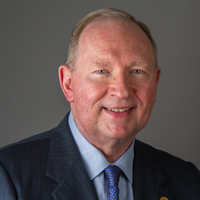Meet Cecilia Payne-Gaposchkin
by John Frost
March 8 was the weekend of the Global Day of the Woman. My tribute to womanhood is to expose The Rotary Club to the life and accomplishments of one Cecilia Payne-Gaposchkin. If you are familiar with the particulars of her life, you need not read further, but if not, you will discover a number of fascinating “firsts” for this exceptional woman.
Cecilia Helena Payne-Gaposchkin (May 10, 1900–December 7, 1979) was a British-born astronomer and astrophysicist who proposed in her 1925 doctoral thesis that stars were composed primarily of hydrogen and helium. The predominant belief at that time held that there were no significant elemental differences between the Sun and Earth. Her journey to discovery illustrates how a determined, hardworking, intelligent immigrant has overcome so many arbitrary obstacles to her accomplishments.
The first obstacle was accepting and adapting to the death of her father when she was four years old. One can imagine the struggles of her mother (also an immigrant from Prussia) raising four little ones in Wendover, England. Cecilia attended St. Paul’s Girls” School. She won a scholarship to Newnham College, Cambridge University where she developed an interest in astronomy inspired by the research of astronomer Arthur Eddington who began to observe and photograph the stars near a solar eclipse as a test of Einstein’s general theory of relativity. Her comment at the time reflects her inspiration to pursue a life of research: “the result was a complete transformation of my world picture. … My world had been so shaken that I experienced something very like a nervous breakdown.” She completed her studies at Cambridge but was not awarded a degree because of her gender; Cambridge did not grant degrees to women until 1948.
After Cambridge, her only career option in the U.K. was to become a teacher, so she looked for grants that would enable her to move to the United States. She left England in 1923 after accepting a fellowship from the Harvard College Observatory designed to encourage women to study at the observatory. (For accuracy, Adelaide Ames had become the first student on the fellowship in 1922; the second was Payne.)
The technology applied to her research observations and conclusions is difficult to understand. In the simplest of terms, it was assumed that the ionization of the earth’s crust at high temperatures was similar to the ionized gasses surrounding the Sun, leading to the conclusion that the composition of the Sun was similar to that of the Earth, mainly various metals, silicon and carbon. And, further, it was concluded that this was true of all stars. Cecilia suspected that this theory was inaccurate and set out to prove it by making observations totaling in the multi-millions (aided by students and other researchers). Her thesis concluded that hydrogen was the overwhelming constituent of stars, making it the most abundant element in the Universe. Her dissertation was reviewed and rejected by astronomer Henry Russell who stood by the theories of physicist Henry Rowland whose belief had been generally accepted. As research continued by other observatories and astronomers, her thesis was finally accepted in 1929 and it is the prevailing view today.
Cecilia spent her entire academic career at Harvard. When she began, women were barred from becoming professors, so she spent years doing less prestigious, low-paid research jobs. Nevertheless, her work resulted in several published books. In 1938 she was given the title of Astronomer which title was changed to Phillips Astronomer. She was elected a Fellow of the American Academy of Arts and Sciences in 1943. Her courses were recorded in the Harvard Catalogue until 1945. In 1956 she became the first woman to be promoted to full professor from within the faculty at Harvard’s Faculty of Arts and Sciences. Finally, she became the first woman to be appointed to the Chair of the Department of Astronomy at Harvard. Her students went on to make important contributions to astronomy. She retired in 1966 and was appointed Emeritus Professor of Harvard. She continued her research on staff at Smithsonian Astrophysical Observatory and actively edited journals and books published by the Observatory.
Now that you have been introduced to Cecilia and I am sure you recognize her contributions to the American Heritage and recognition of women.
And yet, despite her penchant for research which can, at times, be dry and tedious, she created a scientific satire which you may enjoy. She claimed that she has a proof in the efficacy of prayer. She divided her exams in two groups, praying for success only on one, the other one being a control group, no prayer for success. She achieved the higher marks with the latter group!


Very interesting John. Thanks, Pat